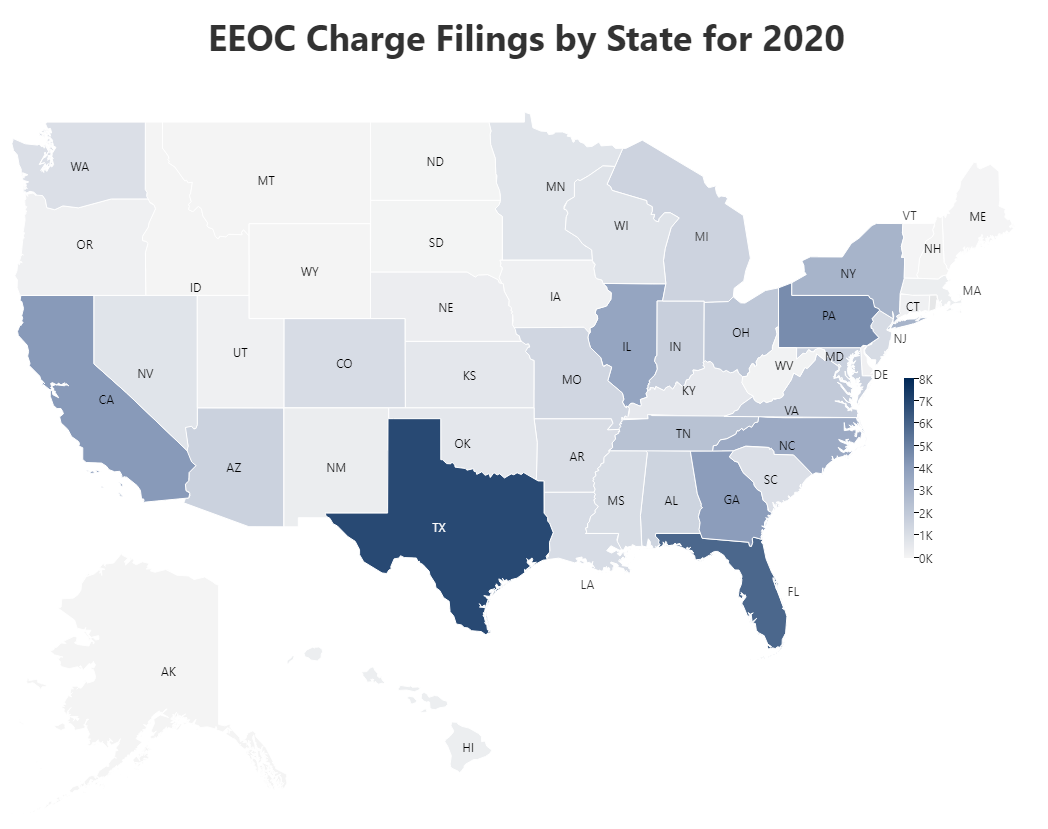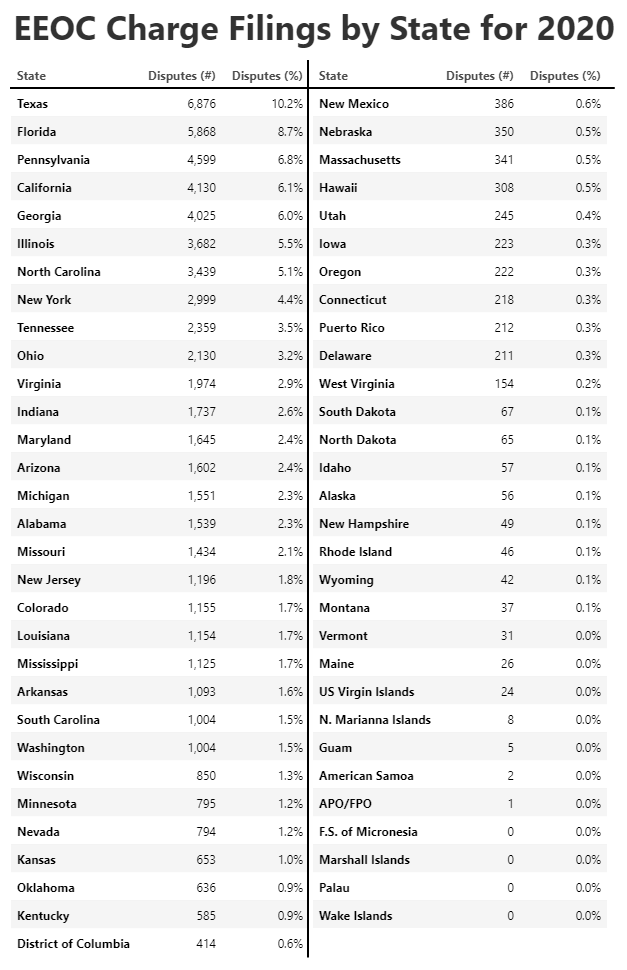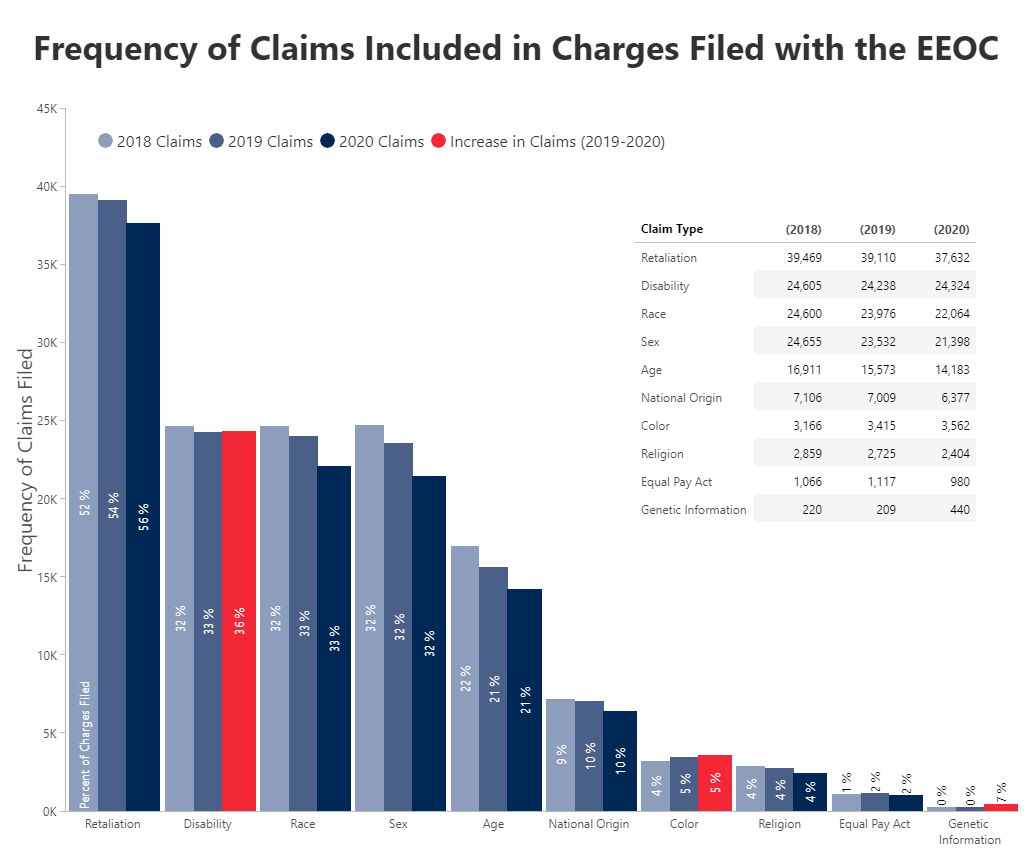As 2021 begins to unfold, we thought employers might benefit from a glimpse into the U.S. Equal Employment Opportunity Commission (EEOC)—where it has been and where it is going. We will begin this multi-part blog series with a snapshot of the EEOC’s own fiscal year (FY) 2020 Enforcement and Litigation Statistics, which the agency released on February 26, 2021. Our analysis of the Enforcement and Litigation Data provides a granular view into the agency’s enforcement efforts during the past year and offers some insights into what employers can expect going forward in 2021.
Charges and Litigation in 2020 by the Numbers
1. Downward Trend in Charges and Litigation; Upward Trend in Overall Recovery
An overall downward trend in numbers of charges and litigation, and an overall increase in recovery for private sector claimants were the overarching themes reflected in the EEOC’s FY2020 Enforcement and Litigation Statistics reporting. The agency touted securing $439.2 million for private sector claimants, including approximately $333.2 million through mediation, conciliation and settlements of charges, and $106 million through litigation in FY2020, significantly overshadowing the $385 million it secured for claimants in FY2019 and $407 million in FY 2018.
2. Number of Charges
At the same time, FY2020 saw the lowest number of charges received from workers in more than two decades. The agency received 67,448 charges—continuing the steady downward trend since 2017 in the numbers of discrimination charges filed with the EEOC.
3. Monetary Resolution of Charges
Despite increased recovery overall, monetary resolutions of charges decreased by $13.4 million, from $346.6 million in FY2019 down to $333.2 million.
4. Most Frequently Filed Claims
Retaliation continues to be the most frequently filed claim included in charges with the EEOC—an astounding 55.8 percent of all charges filed in FY2020 included a retaliation claim, and we do not expect that trend to change any time soon. Categories of claims that showed a slight increase in frequency were disability and color, while genetic information claims saw over a two-fold increase from the prior year. Otherwise the remaining categories all saw slight decreases.
The breakdown, in descending order, of the frequency of claims filed in FY2020 are as follows:
- Retaliation: 37,632 claims (55.8 percent of charges filed)
- Disability: 24,324 (36.1 percent of charges filed)
- Race: 22,064 (32.7 percent of charges filed)
- Sex: 21,398 (31.7 percent of charges filed)
- Age: 14,183 (21.0 percent of charges filed)
- National Origin: 6,377 (9.5 percent of charges filed)
- Color: 3,562 (5.35 percent of charges filed)
- Religion: 2,404 (3.6 percent of charges filed)
- Equal Pay Act: 980 (1.5 percent of charges filed)
- Genetic Information: 440 (0.7 percent of charges filed)
5. Hot Topics
While COVID-19 significantly affected 2020 in many ways, the EEOC’s fiscal year 2020 statistics (which ran from October 1, 2019 through September 30, 2020) only encompassed data from approximately seven months of the pandemic. Recently, EEOC Chair Charlotte Burrows, who was newly appointed, emphasized her view that the pandemic is not only a health and economic crisis, but also a civil rights crisis. As noted above, during FY2020 claims of disability discrimination saw a small uptick in frequency, while genetic information claims saw a considerable increase. Charges that included claims of discrimination based on color also increased slightly. On the other hand, national origin and race discrimination claims showed a slight decrease in frequency despite concerns related to discrimination against Asian Americans and people of Asian descent in the workplace during the pandemic and the larger context of social justice issues that came to the forefront during 2020. The full impact of the pandemic and the social justice movement remains to be seen and a combined review of FY2020 stats with next year’s enforcement data will likely help shed additional light on the impact of these issues on charges filed with the agency.
Also of note, the number of sexual harassment claims dropped to 6,587, down from 7,514 in FY2019. Similarly, the amount of recovery through settlements relating to sexual harassment claims dropped from $68.2 million in FY2019 to $65.3 million in FY2020.
6. Pending Charges
Reducing its backlog of pending private-sector charge inventory continued to be an area of focus for the agency. Pending charges again decreased in FY2020, this year by 3.7 percent to 41,951 charges—which is the lowest in 14 years.
7. Charges by State
Once again, in 2020 more charges were filed in Texas than any other state, with 6876 and Florida came in second with 5868. Pennsylvania followed in third with 4599. The visualization below shows by state where claimants filed most frequently in 2020.


8. Mediations
For FY2020, during part of which the EEOC utilized a mediation pilot program that expanded opportunities for mediation and incorporated video technology for virtual mediation, the EEOC reported that it achieved 6,272 successful private sector mediations resulting in over $156.6 million to claimants—slightly less than $159 million in FY2019.
9. Merits, Systemic, and Non-systemic Lawsuits
In 2020, the EEOC filed only 93 merits lawsuits, including 68 suits on behalf of individuals, 12 nonsystemic suits with multiple claimants, and 13 systemic suits involving multiple claimants or policies. This is down significantly overall as compared to the 144 merits lawsuits filed in FY2019. Systemic litigation filed by the EEOC also dropped again in FY2020. Only 13 systemic suits were filed in FY2020, as compared to 17 systemic suits filed in FY2019, and 39 in FY2018. Chair Burrows recently noted that, going forward, the agency will emphasize enforcement of laws to combat systemic discrimination. Thus, we may see an uptick in systemic suits filed in 2021.
10. Litigation Recovery
One area that demonstrated a significant upward trajectory this year was recovery for claimants through litigation. Monetary benefits for claimants in litigation substantially increased in 2020, to a staggering $106 million—a marked increase from $39.1 million in FY2019 and $53.6 million in FY2018—and resulted in the overall increase in monetary benefits of $439.2 million to private-sector claimants in FY2020.
Stay tuned for part two of our EEOC Roundup series, where we will discuss policy and personnel issues at the agency.
Ogletree Deakins’ EEO Advantage Administrative Charges Program helps employers manage their administrative charges filed with federal, state, and local agencies nationwide. EEO Advantage leverages technology and a thorough understanding of agency processes to manage administrative charges proactively and with budget certainty.







